Exploring the Change in PM2.5 and Ozone Concentrations Caused by Aerosol–Radiation Interactions and Aerosol–Cloud Interactions and the Relationship with Meteorological Factors
Abstract
:1. Introduction
2. Model Configuration and Evaluation
2.1. Model Setting and Design of Sensitivity Tests
2.2. Model Evaluation
2.2.1. Evaluation of Meteorology
2.2.2. Evaluation of Chemistry
3. Results
3.1. Changes of Meteorological Variables and Precursors
3.2. Changes of PM2.5 and Ozone Concentration due to ARIs and ACIs
3.3. Partial Correlation Coefficient Analysis
4. Discussion
5. Conclusions
Supplementary Materials
Author Contributions
Funding
Institutional Review Board Statement
Informed Consent Statement
Data Availability Statement
Acknowledgments
Conflicts of Interest
Appendix A
Explanation of the Calculation in the WRF-Chem Model Regarding the Meteorological Factors and Chemical Species
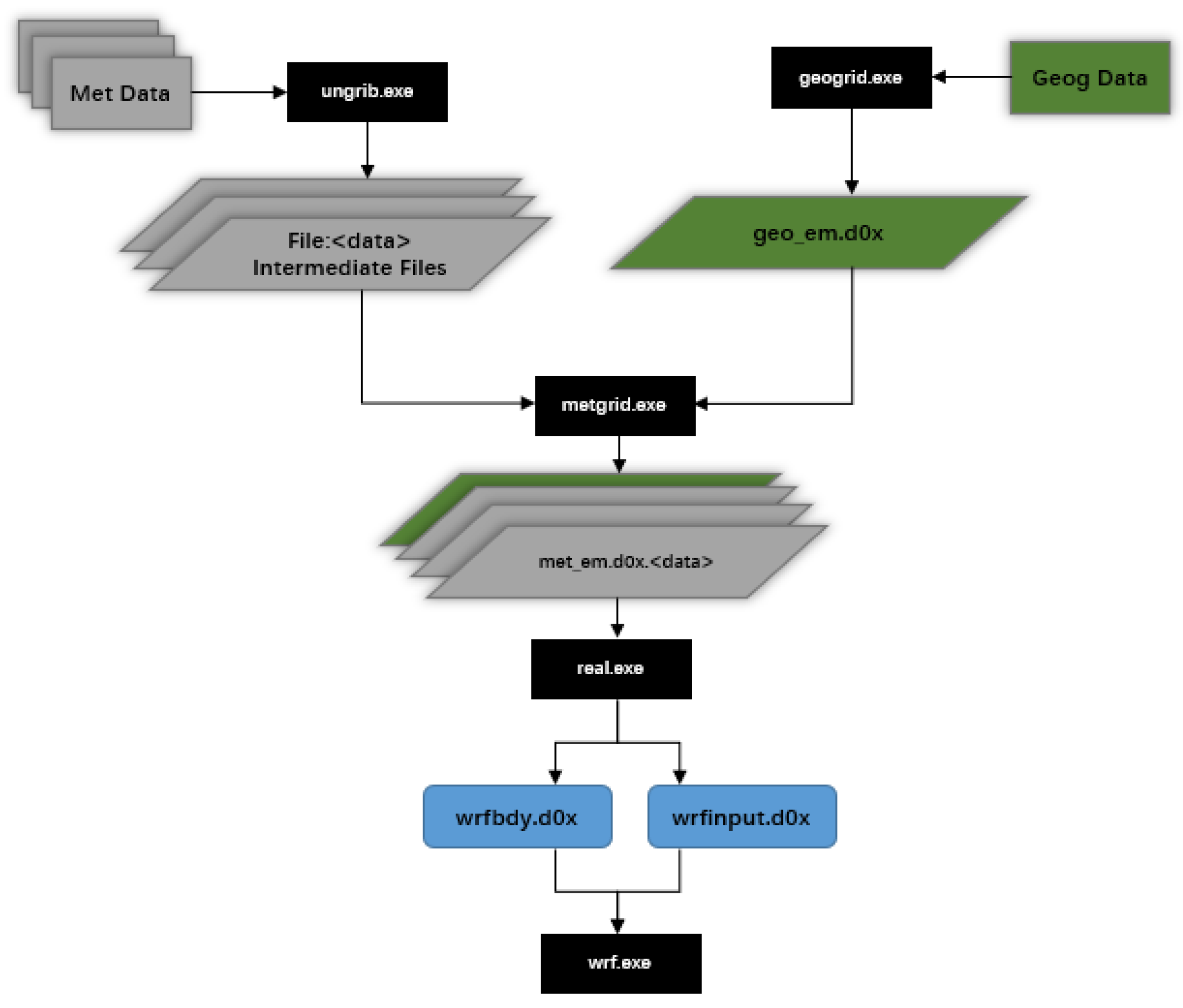
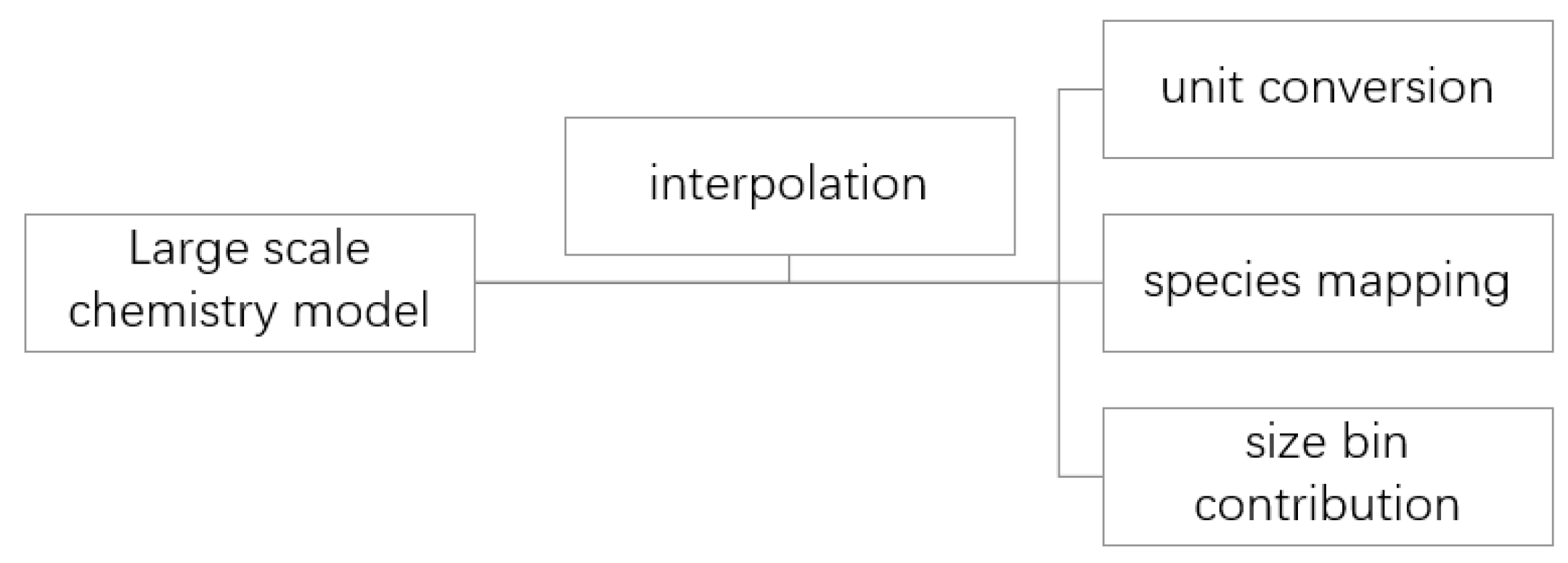


References
- Yang, K.; Kong, L.; Tong, S.; Shen, J.; Chen, L.; Jin, S.; Wang, C.; Sha, F.; Wang, L. Double High-Level Ozone and PM2.5 Co-Pollution Episodes in Shanghai, China: Pollution Characteristics and Significant Role of Daytime HONO. Atmosphere 2021, 12, 557. [Google Scholar] [CrossRef]
- Shu, L.; Wang, T.; Xie, M.; Li, M.; Zhao, M.; Zhang, M.; Zhao, X. Episode study of fine particle and ozone during the CAPUM-YRD over Yangtze River Delta of China: Characteristics and source attribution. Atmos. Environ. 2019, 203, 87–101. [Google Scholar] [CrossRef]
- Xing, J.; Wang, S.X.; Jang, C.; Zhu, Y.; Hao, J.M. Nonlinear response of ozone to precursor emission changes in China: A modeling study using response surface methodology. Atmos. Chem. Phys. 2011, 11, 5027–5044. [Google Scholar] [CrossRef] [Green Version]
- Lu, X.; Hong, J.; Zhang, L.; Cooper, O.R.; Schultz, M.G.; Xu, X.; Wang, T.; Gao, M.; Zhao, Y.; Zhang, Y. Severe Surface Ozone Pollution in China: A Global Perspective. Environ. Sci. Technol. Lett. 2018, 5, 487–494. [Google Scholar] [CrossRef]
- Zheng, B.; Tong, D.; Li, M.; Liu, F.; Hong, C.; Geng, G.; Li, H.; Li, X.; Peng, L.; Qi, J.; et al. Trends in China’s anthropogenic emissions since 2010 as the consequence of clean air actions. Atmos. Chem. Phys. 2018, 18, 14095–14111. [Google Scholar] [CrossRef] [Green Version]
- Zhang, Q.; Zheng, Y.; Tong, D.; Shao, M.; Wang, S.; Zhang, Y.; Xu, X.; Wang, J.; He, H.; Liu, W.; et al. Drivers of improved PM2.5 air quality in China from 2013 to 2017. Proc. Natl. Acad. Sci. USA 2019, 116, 24463–24469. [Google Scholar] [CrossRef] [Green Version]
- Li, K.; Chen, L.; Ying, F.; White, S.J.; Jang, C.; Wu, X.; Gao, X.; Hong, S.; Shen, J.; Azzi, M.; et al. Meteorological and chemical impacts on ozone formation: A case study in Hangzhou, China. Atmos. Res. 2017, 196, 40–52. [Google Scholar] [CrossRef]
- Zhao, S.; Wang, L.; QI, M.; Lu, X.; Wang, Y.; Liu, Z.; Liu, Y.; Tan, J.; Zhang, Y.; Wang, Q.; et al. Study on the characteristics and mutual influence of PM2.5-O3 complex pollution in Handan. Acta Sicentiae Circumstantiae 2021, 41, 2250–2261. [Google Scholar]
- Benas, N.; Mourtzanou, E.; Kouvarakis, G.; Bais, A.; Mihalopoulos, N.; Vardavas, I. Surface ozone photolysis rate trends in the Eastern Mediterranean: Modeling the effects of aerosols and total column ozone based on Terra MODIS data. Atmos. Environ. 2013, 74, 1–9. [Google Scholar] [CrossRef]
- Jia, M.; Zhao, T.; Cheng, X.; Gong, S.; Zhang, X.; Tang, L.; Liu, D.; Wu, X.; Wang, L.; Chen, Y. Inverse Relations of PM2.5 and O3 in Air Compound Pollution between Cold and Hot Seasons over an Urban Area of East China. Atmosphere 2017, 8, 59. [Google Scholar] [CrossRef] [Green Version]
- Zhu, J.; Chen, L.; Liao, H.; Dang, R. Correlations between PM2.5 and Ozone over China and Associated Underlying Reasons. Atmosphere 2019, 10, 352. [Google Scholar] [CrossRef] [Green Version]
- Li, K.; Jacob, D.J.; Liao, H.; Shen, L.; Zhang, Q.; Bates, K.H. Anthropogenic drivers of 2013–2017 trends in summer surface ozone in China. Proc. Natl. Acad. Sci. USA 2019, 116, 422–427. [Google Scholar] [CrossRef] [PubMed] [Green Version]
- Tan, Z.; Fuchs, H.; Lu, K.; Bohn, B.; Broch, S.; Dong, H.; Gomm, S.; Haeseler, R.; He, L.; Hofzumahaus, A.; et al. Radical chemistry at a rural site (Wangdu) in the North China Plain: Observation and model calculations of OH, HO2 and RO2 radicals. Atmos. Chem. Phys. 2017, 17, 4453. [Google Scholar] [CrossRef] [Green Version]
- Wang, B. A novel causality-centrality-based method for the analysis of the impacts of air pollutants on PM2.5 concentrations in China. Sci. Rep. 2021, 11, 6960. [Google Scholar] [CrossRef] [PubMed]
- Yahya, K.; Wang, K.; Zhang, Y.; Kleindienst, T. Application of WRF/Chem over North America under the AQMEII Phase 2–Part 2: Evaluation of 2010 application and responses of air quality and meteorology–chemistry interactions to changes in emissions and meteorology from 2006 to 2010. Geosci. Model. Dev. 2015, 8, 2095–2117. [Google Scholar] [CrossRef] [Green Version]
- Kong, X.; Forkel, R.; Sokhi, R.S.; Suppan, P.; Baklanov, A.; Gauss, M.; Brunner, D.; Barò, R.; Balzarini, A.; Chemel, C. Analysis of meteorology–chemistry interactions during air pollution episodes using online coupled models within AQMEII phase-2. Atmos. Environ. 2015, 115, 527–540. [Google Scholar] [CrossRef]
- Gao, Y.; Zhang, M.; Liu, Z.; Wang, L.; Wang, P.; Xia, X.; Tao, M.; Zhu, L. Modeling the feedback between aerosol and meteorological variables in the atmospheric boundary layer during a severe fog–haze event over the North China Plain. Atmos. Chem. Phys. 2015, 15, 4279–4295. [Google Scholar] [CrossRef] [Green Version]
- Wang, J.; Wang, S.; Jiang, J.; Ding, A.; Zheng, M.; Zhao, B.; Wong, D.C.; Zhou, W.; Zheng, G.; Wang, L. Impact of aerosol–meteorology interactions on fine particle pollution during China’s severe haze episode in January 2013. Environ. Res. Lett. 2014, 9, 094002. [Google Scholar] [CrossRef]
- Zhang, B.; Wang, Y.; Hao, J. Simulating aerosol–radiation–cloud feedbacks on meteorology and air quality over eastern China under severe haze conditionsin winter. Atmos. Chem. Phys. 2015, 15, 2387–2404. [Google Scholar] [CrossRef] [Green Version]
- Gao, M.; Carmichael, G.R.; Wang, Y.; Saide, P.; Yu, M.; Xin, J.; Liu, Z.; Wang, Z. Modeling study of the 2010 regional haze event in the North China Plain. Atmos. Chem. Phys. 2016, 16, 1673–1691. [Google Scholar] [CrossRef] [Green Version]
- Petäjä, T.; Järvi, L.; Kerminen, V.-M.; Ding, A.; Sun, J.; Nie, W.; Kujansuu, J.; Virkkula, A.; Yang, X.; Fu, C. Enhanced air pollution via aerosol-boundary layer feedback in China. Sci. Rep. 2016, 6, 18998. [Google Scholar] [CrossRef] [Green Version]
- Tie, X.; Huang, R.J.; Cao, J.; Zhang, Q.; Cheng, Y.; Su, H.; Chang, D.; Poschl, U.; Hoffmann, T.; Dusek, U.; et al. Severe Pollution in China Amplified by Atmospheric Moisture. Sci. Rep. 2017, 7, 15760. [Google Scholar] [CrossRef]
- Zhao, B.; Liou, K.N.; Gu, Y.; Li, Q.; Jiang, J.H.; Su, H.; He, C.; Tseng, H.R.; Wang, S.; Liu, R.; et al. Enhanced PM2.5 pollution in China due to aerosol-cloud interactions. Sci. Rep. 2017, 7, 4453. [Google Scholar] [CrossRef] [Green Version]
- Gao, Y.; Zhao, C.; Liu, X.; Zhang, M.; Leung, L.R. WRF-Chem simulations of aerosols and anthropogenic aerosol radiative forcing in East Asia. Atmos. Environ. 2014, 92, 250–266. [Google Scholar] [CrossRef]
- Forkel, R.; Balzarini, A.; Baró, R.; Bianconi, R.; Curci, G.; Jiménez-Guerrero, P.; Hirtl, M.; Honzak, L.; Lorenz, C.; Im, U. Analysis of the WRF-Chem contributions to AQMEII phase2 with respect to aerosol radiative feedbacks on meteorology and pollutant distributions. Atmos. Environ. 2015, 115, 630–645. [Google Scholar] [CrossRef]
- Chen, D.-S.; Ma, X.; Xie, X.; Wei, P.; Wen, W.; Xu, T.; Yang, N.; Gao, Q.; Shi, H.; Guo, X. Modelling the effect of aerosol feedbacks on the regional meteorology factors over China. Aerosol. Air. Qual. Res. 2015, 15, 1559–1579. [Google Scholar] [CrossRef] [Green Version]
- Zhou, M.; Zhang, L.; Chen, D.; Gu, Y.; Fu, T.-M.; Gao, M.; Zhao, Y.; Lu, X.; Zhao, B. The impact of aerosol–radiation interactions on the effectiveness of emission control measures. Environ. Res. Lett. 2019, 14, 024002. [Google Scholar] [CrossRef]
- Peng, Y.; Zhang, X.; Zhang, Q. Impact of the implementation of the “Ten Statements of Atmosphere” on the atmospheric aerosol-radiation interaction during 2013–2017. Acta Sicentiae Circumstantiae 2021, 41, 311–320. [Google Scholar]
- Li, M.; Zhang, Q.; Kurokawa, J.-I.; Woo, J.; He, K.; Lu, Z.; Ohara, T.; Song, Y.; Streets, D.; Carmichael, G. MIX: A mosaic Asian anthropogenic emission inventory for the MICS-Asia and the HTAP projects. Atmos. Chem. Phys. Discuss. 2015, 15, 34813–34869. [Google Scholar]
- Guenther, A.; Karl, T.; Harley, P.; Wiedinmyer, C.; Palmer, P.I.; Geron, C. Estimates of global terrestrial isoprene emissions using MEGAN (Model of Emissions of Gases and Aerosols from Nature). Atmos. Chem. Phys. 2006, 6, 3181–3210. [Google Scholar] [CrossRef] [Green Version]
- Iacono, M.J.; Delamere, J.S.; Mlawer, E.J.; Shephard, M.W.; Clough, S.A.; Collins, W.D. Radiative forcing by long-lived greenhouse gases: Calculations with the AER radiative transfer models. J. Geophys. Res. Atmos. 2008, 113, D13103. [Google Scholar] [CrossRef]
- Gettelman, A.; Morrison, H. A New Two-Moment Bulk Stratiform Cloud Microphysics Scheme in the Community Atmosphere Model, Version 3 (CAM3). Part I: Description and Numerical Tests. J. Clim. 2008, 21, 3642–3659. [Google Scholar] [CrossRef]
- Kain, J.S. The Kain–Fritsch convective parameterization: An update. J. Appl. Meteorol. Climatol. 2004, 43, 170–181. [Google Scholar] [CrossRef] [Green Version]
- Jiménez, P.A.; Dudhia, J. On the ability of the WRF model to reproduce the surface wind direction over complex terrain. J. Appl. Meteorol. Climatol. 2013, 52, 1610–1617. [Google Scholar] [CrossRef]
- Foken, T. 50 years of the Monin–Obukhov similarity theory. Bound. Layer Meteorol. 2006, 119, 431–447. [Google Scholar] [CrossRef]
- Hong, S.-Y.; Noh, Y.; Dudhia, J. A new vertical diffusion package with an explicit treatment of entrainment processes. Mon. Weather Rev. 2006, 134, 2318–2341. [Google Scholar] [CrossRef] [Green Version]
- Wild, O.; Zhu, X.; Prather, M.J. Fast-J: Accurate simulation of in-and below-cloud photolysis in tropospheric chemical models. J. Atmos. Chem. 2000, 37, 245–282. [Google Scholar] [CrossRef]
- San José, R.; Pérez, J.; Balzarini, A.; Baró, R.; Curci, G.; Forkel, R.; Galmarini, S.; Grell, G.; Hirtl, M.; Honzak, L. Sensitivity of feedback effects in CBMZ/MOSAIC chemical mechanism. Atmos. Environ. 2015, 115, 646–656. [Google Scholar] [CrossRef] [Green Version]
- Makar, P.; Gong, W.; Milbrandt, J.; Hogrefe, C.; Zhang, Y.; Curci, G.; Žabkar, R.; Im, U.; Balzarini, A.; Baró, R. Feedbacks between air pollution and weather, Part 1: Effects on weather. Atmos. Environ. 2015, 115, 442–469. [Google Scholar] [CrossRef]
- Makar, P.; Gong, W.; Hogrefe, C.; Zhang, Y.; Curci, G.; Žabkar, R.; Milbrandt, J.; Im, U.; Balzarini, A.; Baró, R. Feedbacks between air pollution and weather, Part 2: Effects on chemistry. Atmos. Environ. 2015, 115, 499–526. [Google Scholar] [CrossRef]
- Wang, L.; Zhang, Y.; Wang, K.; Zheng, B.; Zhang, Q.; Wei, W. Application of Weather Research and Forecasting Model with Chemistry (WRF/Chem) over northern China: Sensitivity study, comparative evaluation, and policy implications. Atmos. Environ. 2016, 124, 337–350. [Google Scholar] [CrossRef] [Green Version]
- Tao, X.; Huang, J.; Xie, X.; Wang, Y.; Bao, Y.; Liu, C.; Zhang, X.; Xu, J. Observational Analysis of the Influence of Aerosol Radiation Effect on Planetary Boundary Layer Structure and Entrainment Characteristics. Chin. J. Atmos. Sci. 2020, 44, 1213–1233. [Google Scholar]
- Zhang, X.; Zhang, Q.; Hong, C.; Zheng, Y.; Geng, G.; Tong, D.; Zhang, Y.; Zhang, X. Enhancement of PM2.5 Concentrations by Aerosol-Meteorology Interactions over China. J. Geophys. Res. Atmos. 2018, 123, 1179–1194. [Google Scholar] [CrossRef]
- Wang, X.; Shen, X.J.; Sun, J.Y.; Zhang, X.Y.; Wang, Y.Q.; Zhang, Y.M.; Wang, P.; Xia, C.; Qi, X.F.; Zhong, J.T. Size-resolved hygroscopic behavior of atmospheric aerosols during heavy aerosol pollution episodes in Beijing in December 2016. Atmos. Environ. 2018, 194, 188–197. [Google Scholar] [CrossRef]
- Gao, M.; Carmichael, G.R.; Wang, Y.; Ji, D.; Liu, Z.; Wang, Z. Improving simulations of sulfate aerosols during winter haze over Northern China: The impacts of heterogeneous oxidation by NO2. Front. Environ. Sci. Eng. 2016, 10, 1–11. [Google Scholar] [CrossRef]
- Archernicholls, S. Evaluated Developments in the WRF-Chem Model; Comparison with Observations and Evaluation of Impacts. Ph.D. Thesis, University of Manchester, Manchester, UK, 2014. [Google Scholar]
- Dong, X.; Fu, J.S. Understanding interannual variations of biomass burning from Peninsular Southeast Asia, Part I: Model evaluation and analysis of systematic bias. Atmos. Environ. 2015, 116, 293–307. [Google Scholar] [CrossRef]
- Koh, T.Y.; Fonseca, R. Subgrid-scale cloud-radiation feedback for the Betts-Miller-Janji convection scheme. Q. J. R. Meteorol. Soc. 2016, 142, 989–1006. [Google Scholar] [CrossRef] [Green Version]
- Zhang, Y.; Zhang, X.; Wang, K.; Zhang, Q.; Duan, F.; He, K. Application of WRF/Chem over East Asia: Part II. Model improvement and sensitivity simulations. Atmos. Environ. 2016, 124, 301–320. [Google Scholar] [CrossRef] [Green Version]
- Herwehe, J.A.; Alapaty, K.; Spero, T.L.; Nolte, C.G. Increasing the credibility of regional climate simulations by introducing subgrid-scale cloud-radiation interactions. J. Geophys. Res. Atmos. 2014, 119, 5317–5330. [Google Scholar] [CrossRef]
- Sha, T.; Ma, X.; Wang, J.; Tian, R.; Zhao, J.; Cao, F.; Zhang, Y.-L. Improvement of inorganic aerosol component in PM2.5 by constraining aqueous-phase formation of sulfate in cloud with satellite retrievals: WRF-Chem simulations. Sci. Total Environ. 2022, 804, 150229. [Google Scholar] [CrossRef]
- Onwukwe, C.; Jackson, P.L. Acid wet-deposition modeling sensitivity to WRF-CMAQ planetary boundary layer schemes and exceedance of critical loads over an industrializing coastal valley in northwestern British Columbia, Canada. Atmos. Pollut. Res. 2021, 12, 231–244. [Google Scholar] [CrossRef]
- Ying, Z.; Tie, X.; Li, G. Sensitivity of ozone concentrations to diurnal variations of surface emissions in Mexico City: A WRF/Chem modeling study. Atmos. Environ. 2009, 43, 851–859. [Google Scholar] [CrossRef]
- Lei, S.; Xue, L.; Wang, Y.; Li, L.; Wang, W. Impacts of meteorology and emissions on summertime surface ozone increases over central eastern China between 2003 and 2015. Atmos. Chem. Phys. 2019, 19, 1455–1469. [Google Scholar]
- Vohra, K.; Vodonos, A.; Schwartz, J.; Marais, E.A.; Mickley, L.J. Global mortality from outdoor fine particle pollution generated by fossil fuel combustion: Results from GEOS-Chem. Environ. Res. 2021, 195, 110754. [Google Scholar] [CrossRef]
- Jeong, G.-R. Weather Effects of Aerosols in the Global Forecast Model. Atmosphere 2020, 11, 850. [Google Scholar] [CrossRef]
- Schnell, J.L.; Holmes, C.D.; Jangam, A.; Prather, M.J. Skill in forecasting extreme ozone pollution episodes with a global atmospheric chemistry model. Atmos. Chem. Phys. 2014, 14, 7721–7739. [Google Scholar] [CrossRef] [Green Version]
- Kang, J.Y.; Bae, S.Y.; Park, R.S.; Han, J.Y. Aerosol indirect effects on the predicted precipitation in a global weather forecasting model. Atmosphere 2019, 10, 392. [Google Scholar] [CrossRef] [Green Version]
- Gao, Y.; Chen, F.; Miguez-Macho, G.; Li, X. Understanding precipitation recycling over the Tibetan Plateau using tracer analysis with WRF. Clim. Dyn. 2020, 55, 2921–2937. [Google Scholar] [CrossRef]
- Kim, G.; Lee, J.; Lee, M.I.; Kim, D. Impacts of urbanization on atmospheric circulation and aerosol transport in a coastal environment simulated by the WRF-Chem coupled with urban canopy model. Atmos. Environ. 2021, 249, 118253. [Google Scholar] [CrossRef]
- da Cunha Luz Barcellos, P.; Cataldi, M. Flash flood and extreme rainfall forecast through one-way coupling of WRF-SMAP models: Natural hazards in Rio de Janeiro state. Atmosphere 2020, 11, 834. [Google Scholar] [CrossRef]
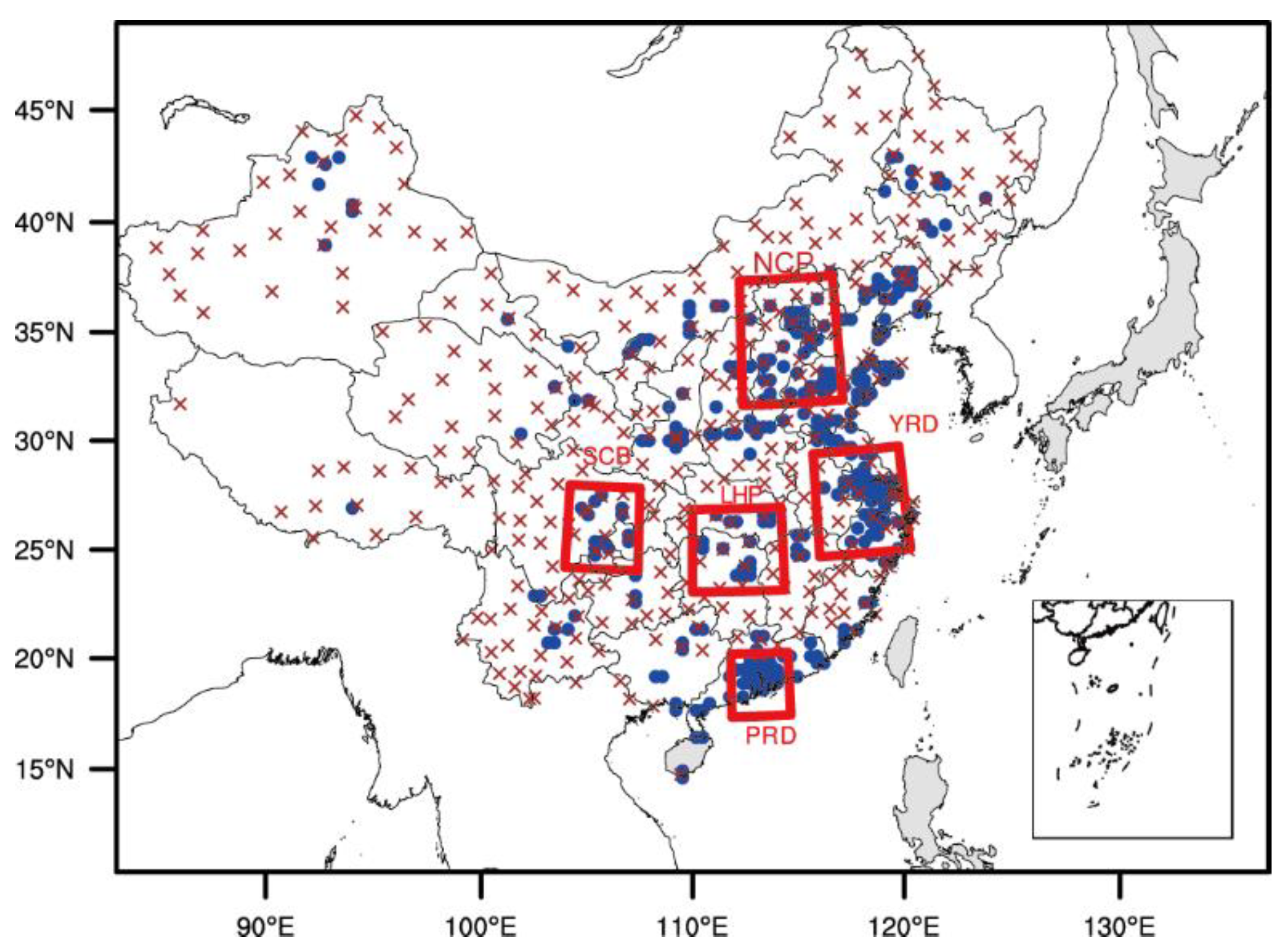
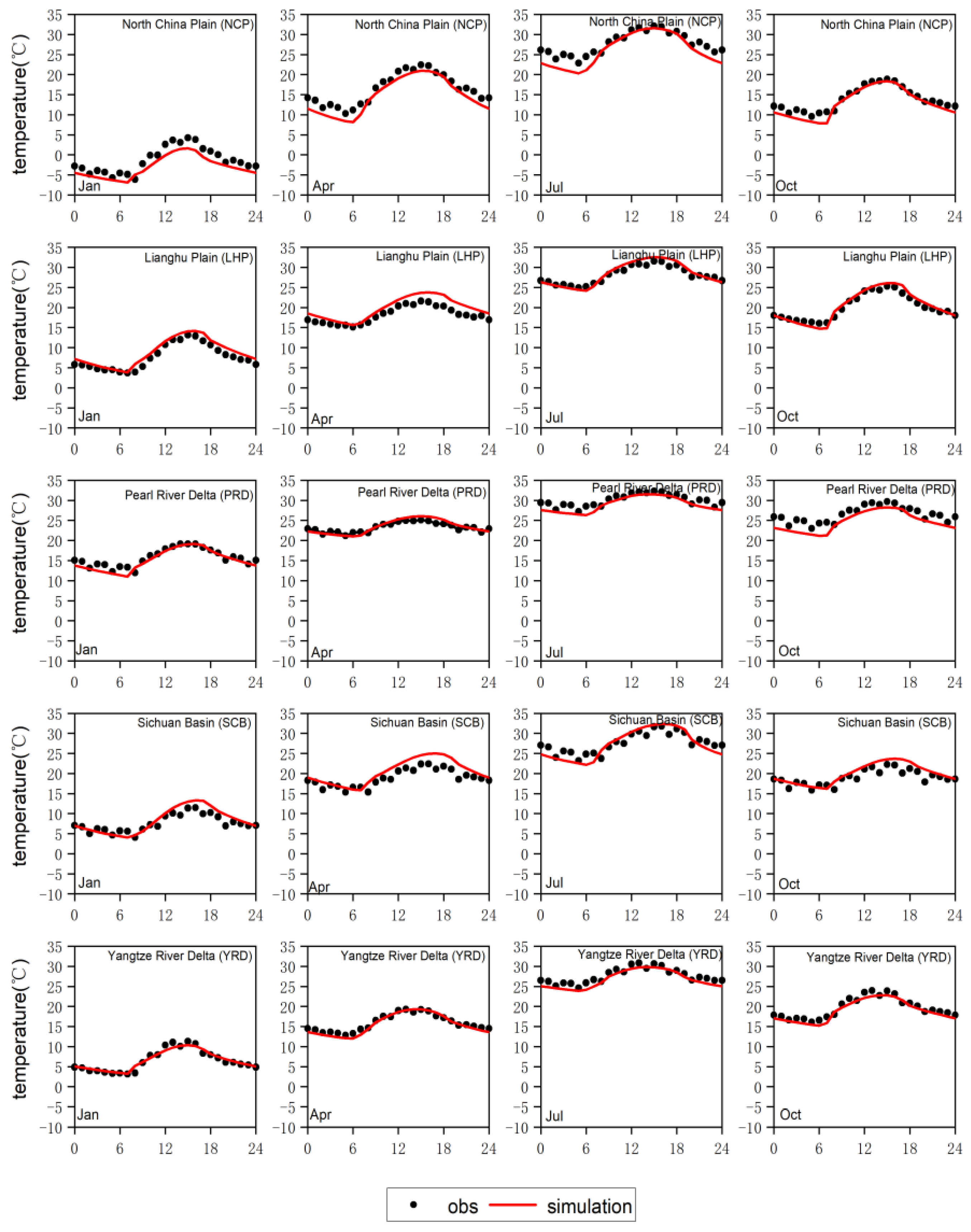
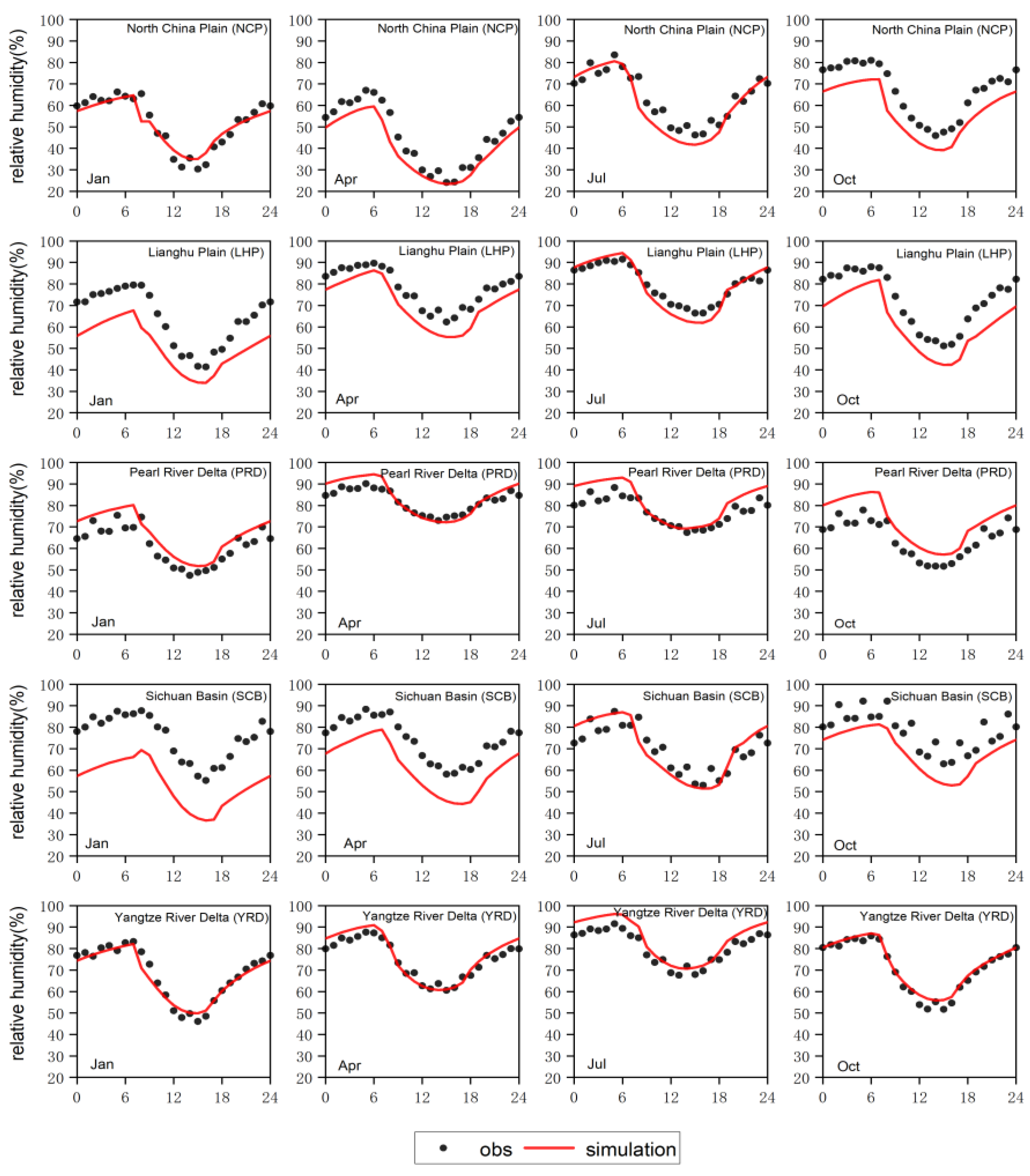


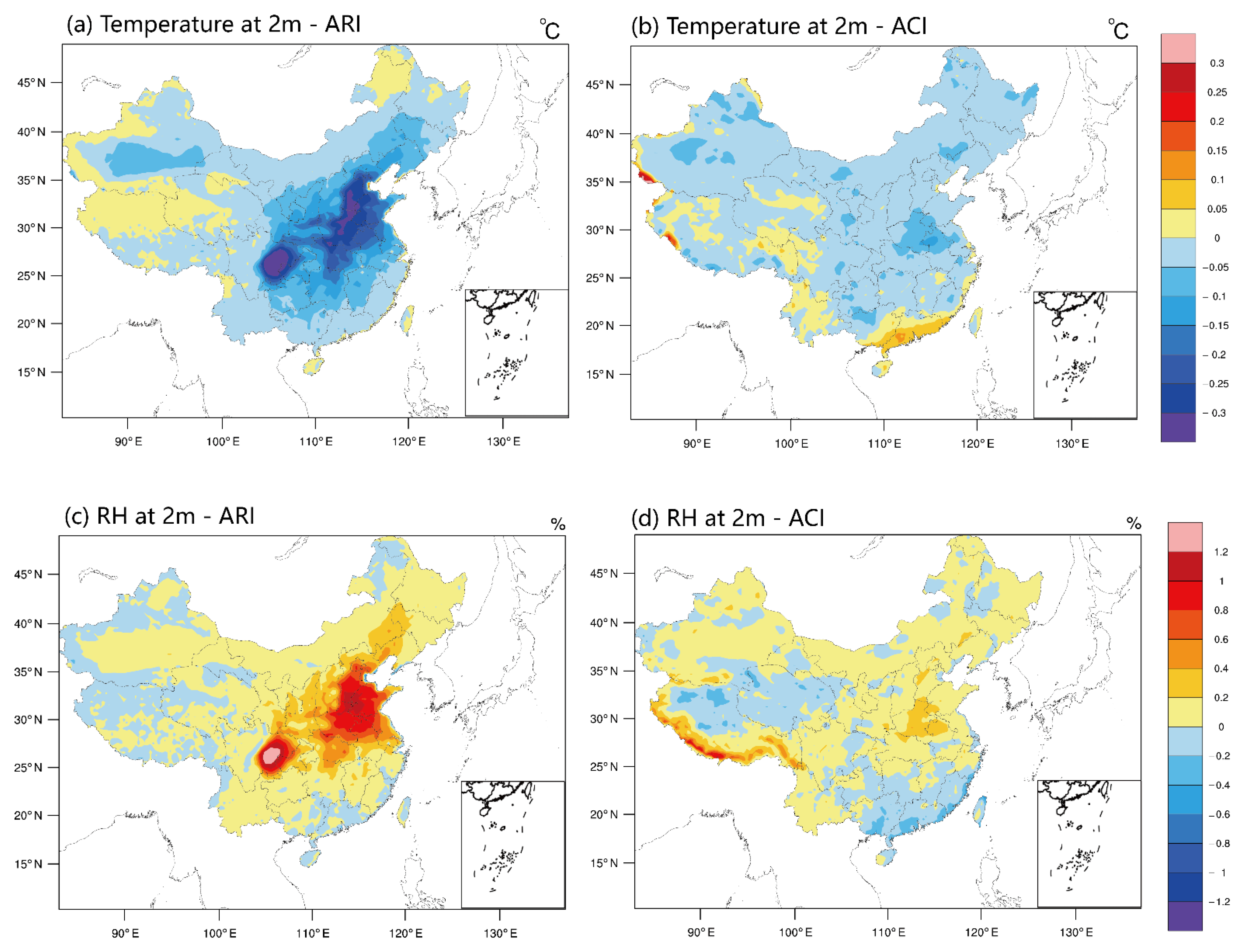


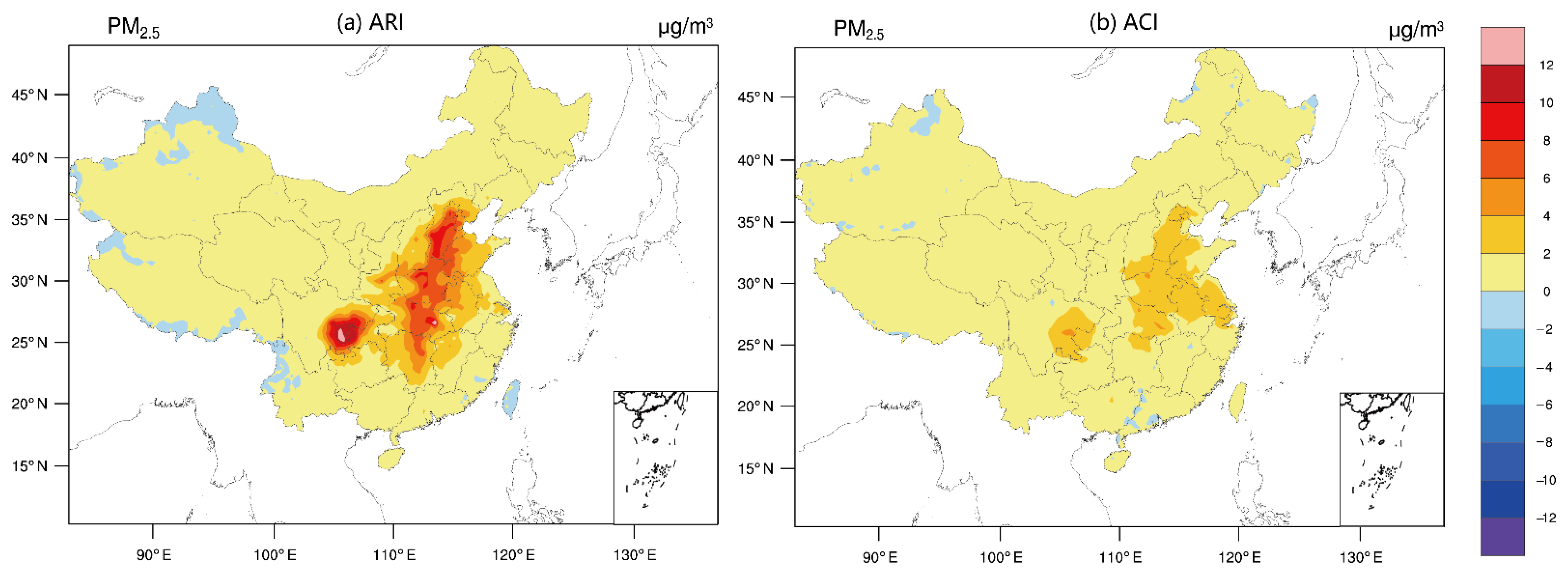
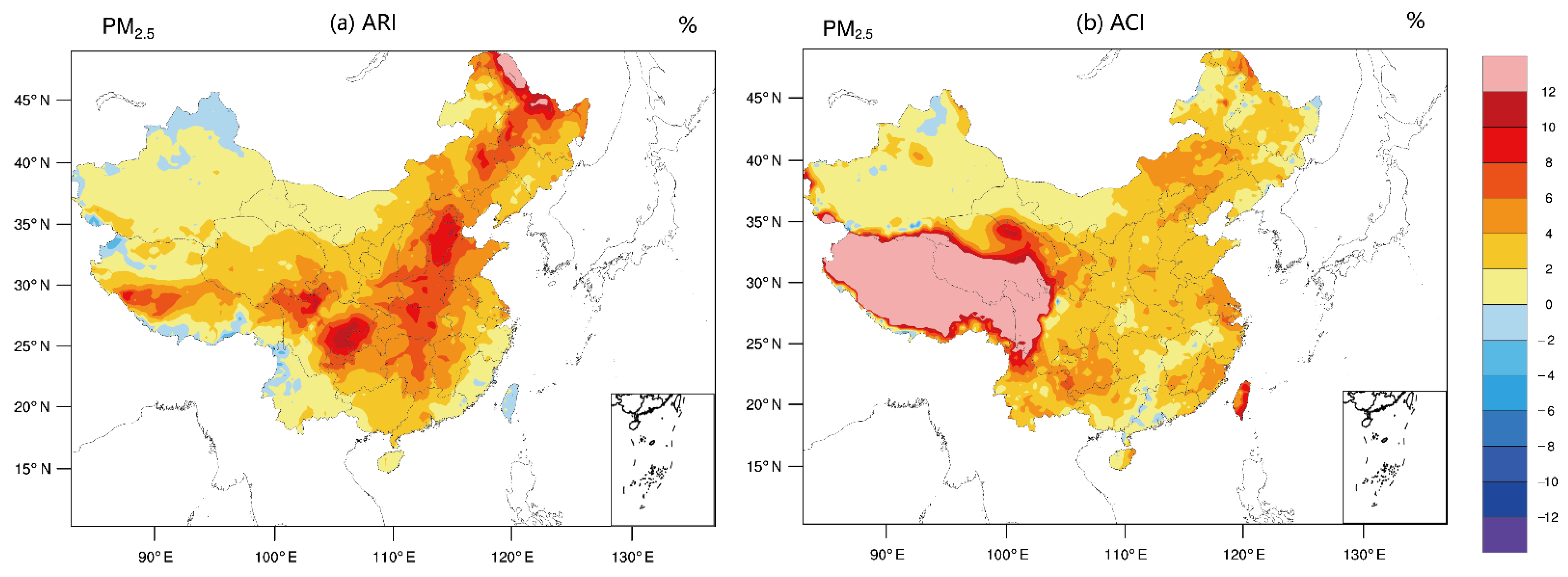
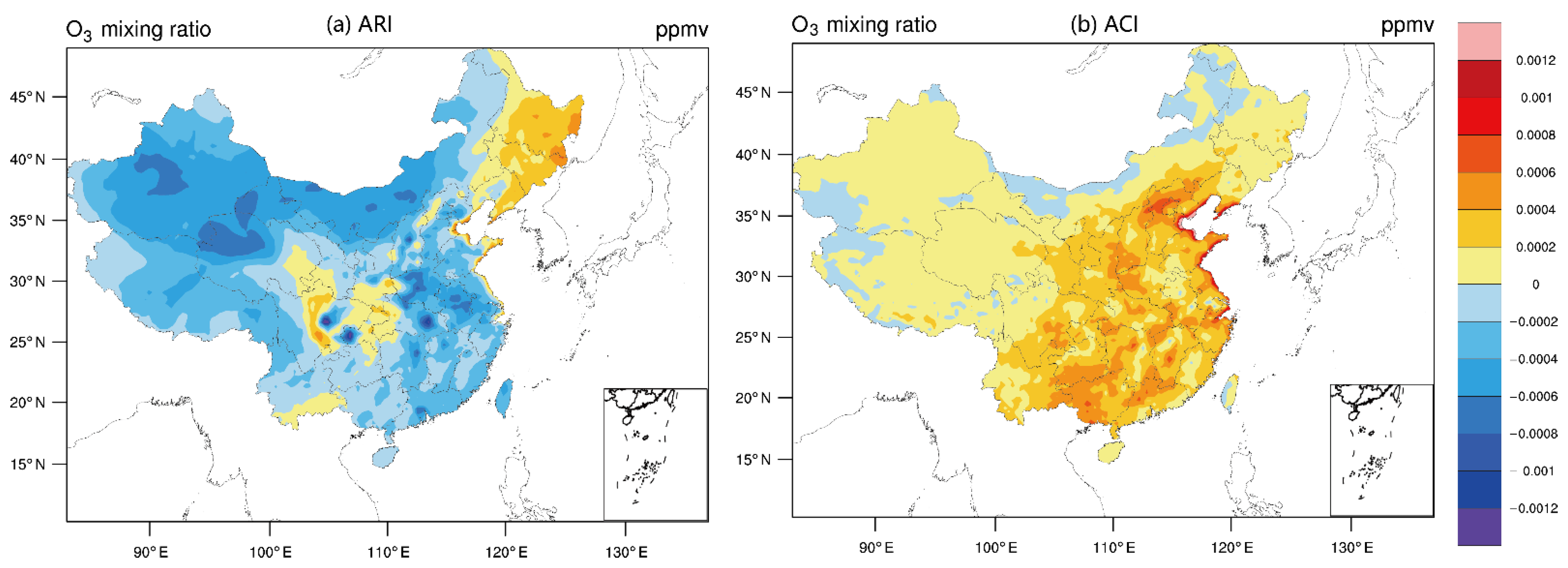
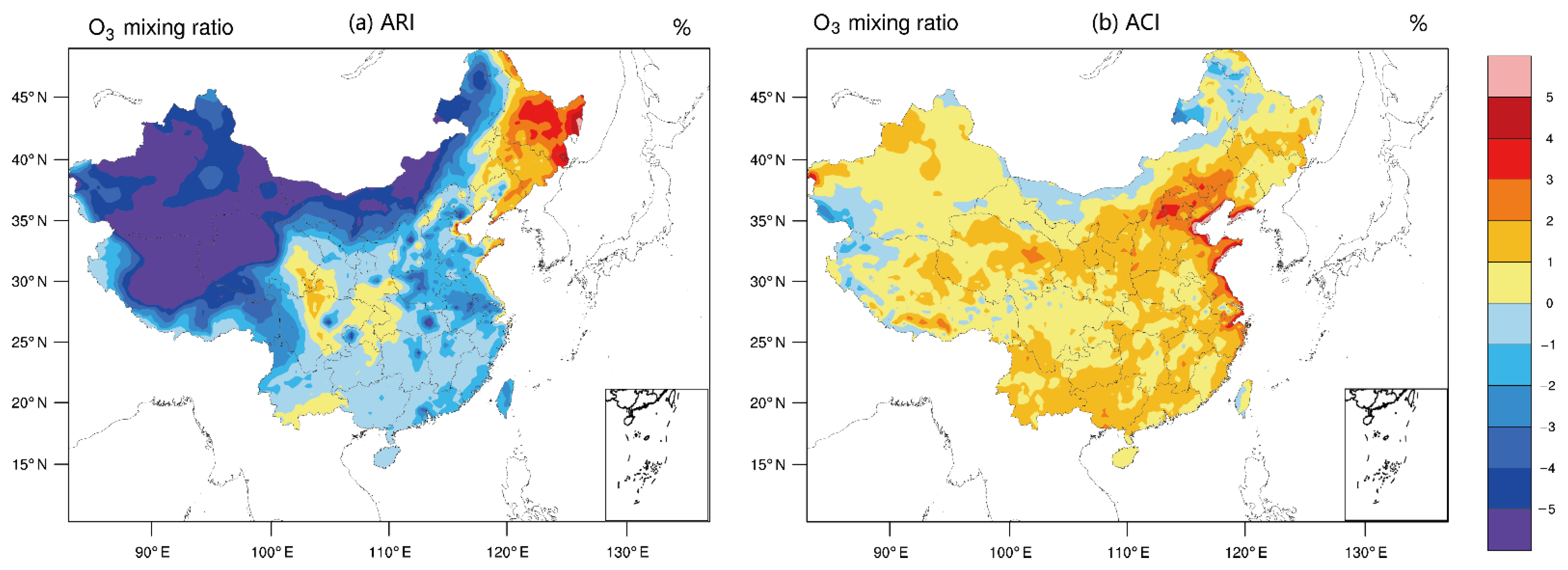

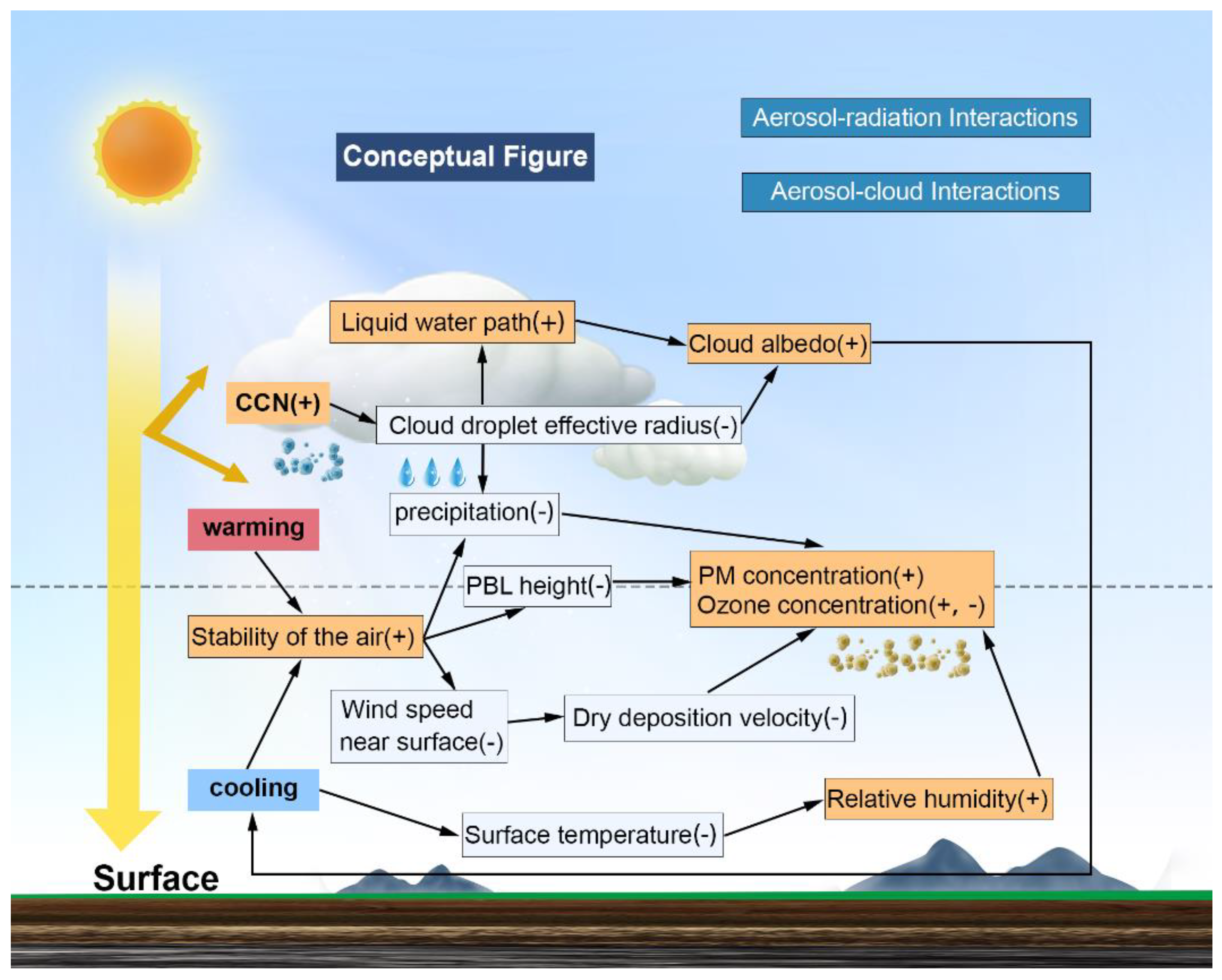
| Region | Range of Latitude (Degree N) | Range of Longitude (Degree E) | Number of Ground-Based Sites |
|---|---|---|---|
| North China Plain (NCP) | 38–41 | 115–119 | 58 |
| Sichuan Basin (SCB) | 28–32 | 103–107 | 24 |
| Lianghu Plain (LHP) | 27–31 | 112–115 | 31 |
| Yangtze River Delta (YRD) | 29.5–32.5 | 112–122 | 53 |
| Pearl River Delta (PRD) | 21–24 | 112–115 | 35 |
| Tests | Aerosol-Radiation Interactions | Aerosol-Cloud Interactions |
|---|---|---|
| BASE | √ | √ |
| RAD | √ | × |
| NON | × | × |
| Temperature (℃) | Relative Humidity (%) | Wind Speed (m/s) | Precipitation (mm) | |
|---|---|---|---|---|
| Mean Observation | 16.07 | 67.85 | 2.74 | 112.43 |
| Mean Simulation | 15.26 | 69.69 | 3.43 | 106.83 |
| Correlation Coefficient | 0.94 | 0.70 | 0.54 | 0.73 |
| Mean Bias | −0.81 | 1.84 | 0.69 | −5.60 |
| Root Mean Square Error | 3.31 | 15.66 | 2.64 | 53.32 |
| Normalized Mean Bias (%) | −5.04 | 2.71 | 25.23 | −4.98 |
| Normalized Mean Error (%) | 15.29 | 17.69 | 67.47 | 87.93 |
| Month | Observation | Simulation | Correlation | Mean Bias | Root Mean Square Error | Normalized Mean Bias (%) | Normalized Mean Error (%) | |
|---|---|---|---|---|---|---|---|---|
| CO | 1 | 1.60 | 1.35 | 0.42 | −0.25 | 1.03 | −15.61 | 45.66 |
| 4 | 0.98 | 0.60 | 0.25 | −0.39 | 0.60 | −39.24 | 46.11 | |
| 7 | 0.83 | 0.52 | 0.17 | −0.31 | 0.62 | −36.97 | 46.69 | |
| 10 | 1.02 | 0.67 | 0.33 | −0.35 | 0.62 | −34.46 | 45.05 | |
| NO2 | 1 | 48.30 | 51.96 | 0.61 | 3.66 | 28.06 | 7.58 | 45.08 |
| 4 | 32.84 | 32.76 | 0.60 | −0.08 | 19.49 | −0.24 | 45.12 | |
| 7 | 23.71 | 31.14 | 0.49 | 7.43 | 22.27 | 31.33 | 66.84 | |
| 10 | 37.31 | 41.30 | 0.62 | 3.99 | 23.80 | 10.69 | 48.34 | |
| SO2 | 1 | 52.03 | 60.97 | 0.42 | 8.94 | 63.92 | 17.19 | 70.42 |
| 4 | 22.72 | 24.26 | 0.31 | 1.54 | 24.45 | 6.78 | 66.52 | |
| 7 | 14.95 | 20.46 | 0.20 | 5.50 | 21.99 | 36.78 | 91.27 | |
| 10 | 22.61 | 33.76 | 0.34 | 11.15 | 33.36 | 49.29 | 88.40 | |
| PM10 | 1 | 129.76 | 75.39 | 0.67 | −54.37 | 79.50 | −41.90 | 46.79 |
| 4 | 93.59 | 41.77 | 0.52 | −51.82 | 71.16 | −55.37 | 57.53 | |
| 7 | 66.11 | 34.32 | 0.52 | −31.80 | 45.07 | −48.09 | 52.25 | |
| 10 | 93.80 | 45.56 | 0.55 | −48.24 | 67.98 | −51.43 | 54.41 | |
| PM2.5 | 1 | 85.36 | 66.13 | 0.66 | −19.24 | 47.94 | −22.53 | 40.19 |
| 4 | 48.47 | 34.75 | 0.55 | −13.72 | 26.61 | −28.30 | 39.74 | |
| 7 | 37.13 | 28.29 | 0.59 | −8.84 | 20.94 | −23.81 | 40.28 | |
| 10 | 52.22 | 37.05 | 0.56 | −15.17 | 33.80 | −29.05 | 43.22 | |
| O3 | 1 | 35.10 | 47.57 | 0.51 | 12.47 | 27.47 | 35.52 | 57.37 |
| 4 | 67.73 | 71.17 | 0.52 | 3.44 | 30.08 | 5.08 | 34.92 | |
| 7 | 75.13 | 83.34 | 0.47 | 8.21 | 31.59 | 10.93 | 32.00 | |
| 10 | 59.06 | 64.56 | 0.56 | 5.49 | 28.78 | 9.30 | 37.02 |
| January | April | July | October | ||
|---|---|---|---|---|---|
| Wind speed | NCP | x | x | x | x |
| SCB | x | x | x | x | |
| YRD | x | x | x | x | |
| PRD | x | x | −0.40 | x | |
| LHP | x | x | x | x | |
| PBL height | NCP | −0.45 | −0.38 | x | x |
| SCB | −0.48 | x | x | x | |
| YRD | x | −0.42 | −0.38 | −0.55 | |
| PRD | −0.77 | x | x | −0.54 | |
| LHP | −0.40 | −0.51 | −0.40 | −0.47 | |
| Relative humidity | NCP | x | 0.51 | x | x |
| SCB | x | 0.38 | x | x | |
| YRD | x | x | x | x | |
| PRD | x | x | x | x | |
| LHP | x | x | x | x |
| NCP | SCB | LHP | YRD | PRD | |
|---|---|---|---|---|---|
| NO2 | x | −0.68 | −0.76 | −0.63 | x |
| PBL Height | x | x | x | x | x |
| RH | −0.52 | x | x | x | x |
| Temperature | 0.44 | x | x | x | x |
| Wind Speed | x | x | x | x | x |
| Radiation | x | x | 0.72 | 0.43 | x |
| SOR | x | x | 0.52 | 0.40 | x |
| NOR | x | 0.81 | x | x | x |
Publisher’s Note: MDPI stays neutral with regard to jurisdictional claims in published maps and institutional affiliations. |
© 2021 by the authors. Licensee MDPI, Basel, Switzerland. This article is an open access article distributed under the terms and conditions of the Creative Commons Attribution (CC BY) license (https://creativecommons.org/licenses/by/4.0/).
Share and Cite
Zhang, X.; Yuan, C.; Zhuang, Z. Exploring the Change in PM2.5 and Ozone Concentrations Caused by Aerosol–Radiation Interactions and Aerosol–Cloud Interactions and the Relationship with Meteorological Factors. Atmosphere 2021, 12, 1585. https://doi.org/10.3390/atmos12121585
Zhang X, Yuan C, Zhuang Z. Exploring the Change in PM2.5 and Ozone Concentrations Caused by Aerosol–Radiation Interactions and Aerosol–Cloud Interactions and the Relationship with Meteorological Factors. Atmosphere. 2021; 12(12):1585. https://doi.org/10.3390/atmos12121585
Chicago/Turabian StyleZhang, Xin, Chengduo Yuan, and Zibo Zhuang. 2021. "Exploring the Change in PM2.5 and Ozone Concentrations Caused by Aerosol–Radiation Interactions and Aerosol–Cloud Interactions and the Relationship with Meteorological Factors" Atmosphere 12, no. 12: 1585. https://doi.org/10.3390/atmos12121585
APA StyleZhang, X., Yuan, C., & Zhuang, Z. (2021). Exploring the Change in PM2.5 and Ozone Concentrations Caused by Aerosol–Radiation Interactions and Aerosol–Cloud Interactions and the Relationship with Meteorological Factors. Atmosphere, 12(12), 1585. https://doi.org/10.3390/atmos12121585






